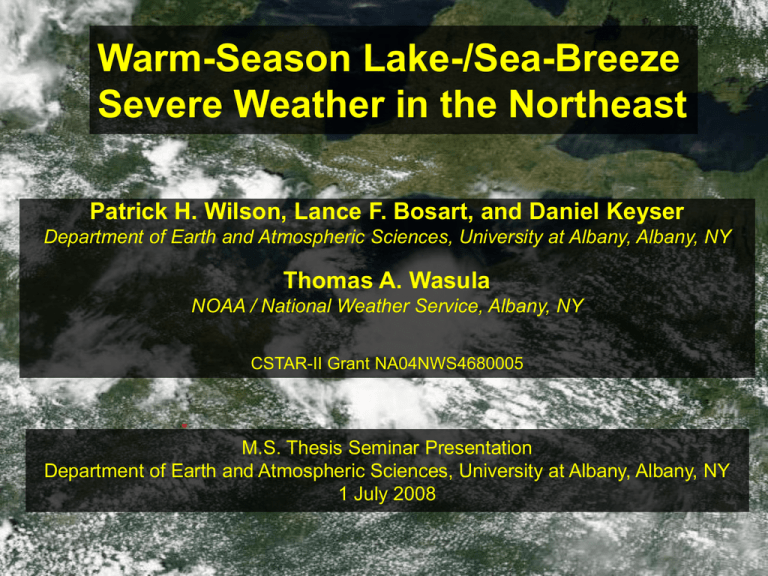Warm-Season Lake-/Sea-Breeze Severe Weather in the
advertisement

Warm-Season Lake-/Sea-Breeze Severe Weather in the Northeast Patrick H. Wilson, Lance F. Bosart, and Daniel Keyser Department of Earth and Atmospheric Sciences, University at Albany, Albany, NY Thomas A. Wasula NOAA / National Weather Service, Albany, NY CSTAR-II Grant NA04NWS4680005 M.S. Thesis Seminar Presentation Department of Earth and Atmospheric Sciences, University at Albany, Albany, NY 1 July 2008 Background and Motivation Sea breezes studied well before 20th century and accurately described thermodynamically: Wales (1914) and Clowes (1917) Complexity of sea-breeze front due to its lobe-and-cleft structure not realized until recently: Galvin (2006) Images from http://weather.cod.edu/sirvatka/seabreeze.html (top) and Fig. 1 from Galvin (2006) (bottom) Background and Motivation (continued) 5 m s−1 offshore prevailing geostrophic wind 5 m s−1 onshore prevailing geostrophic wind Significant impact of prevailing synoptic-scale flow pattern on sea breeze evolution and intensity: Estoque (1962) Fig. 5 (left) and Fig. 9 (right) from Estoque (1962) Background and Motivation (continued) Many examples of sea-breeze convection cases found in literature: Kingsmill (1995) in FL, Medlin and Croft (1998) in AL, Bennett et al. (2006) in Great Britain, etc. Fewer cases in literature for Northeast exist: Moroz and Hewson (1966) from MI, Clodman and Chisholm (1994) and King et al. (2003) from Ontario, and Wolf (2004) in IL Lots of research for Great Lakes during winter (lake-effect snow), but much less research during summer (lake-/seabreeze severe convection) Research Goals Investigate influence of thermodynamic and dynamical processes, along with physiographic effects from complex Northeast topography, on lake-/sea-breeze severe weather Increase awareness and understanding of lake- /sea-breeze severe convection VT Methodology ME NH NY PA Warm season: April–October OH MD MA RI CT NJ DE Domain area shown by map Selected cases from search of SPC archived storm data, along with input from NWS meteorologists, for 2000–2006 Verified from NCDC archived radar data Methodology (continued) Obtained 32 km-resolution NCEP/NARR gridded datasets for all cases to perform synoptic-scale analyses Acquired 20 km-resolution RUC gridded datasets for three cases to perform mesoscale analyses Collected soundings, radar data, satellite images, water temperature data, and surface observations Classified cases into separate categories and conducted case study analyses Case Classifications Pure Case: mesoscale forcing primary; synoptic-scale forcing secondary Mixed Case: mesoscale forcing and synoptic- scale forcing of similar importance Null Case: convection suppressed by lake-/sea-breeze processes Case List Cases chosen for RUC analysis highlighted Pure Cases Mixed Cases 9 August 2001 (Ontario) 6 July 2003 (Erie) 7 August 2005 (Chesapeake) 2 August 2006 (Ontario) 19 April 2002 (Erie) 19 June 2002 (Atlantic) 24 July 2003 (Erie and Ontario) 1 August 2005 (Huron and Ontario) 30 June 2006 (Erie and Ontario) 23 July 2006 (Erie and Ontario) Null Case 11 July 2006 (Atlantic) Legend Red: Storm Formation Areas Pink: Tornado Risk Area Green: Null Case Area Arrows: Storm Tracks Storm Formation Areas and Tracks: All Cases SPC Verification of Cases using Convective Outlook Reports for 2003–2006 Pure Cases (3) Slight Risk: 2, General Thunderstorms: 1 Mixed Cases (4) Slight Risk: 1, General Thunderstorms: 3 Null Case (1) Missed Null Area (Slight Risk) Pure Case Example 2 August 2006 (Ontario) 2 4 6 8 10 1200 UTC 2 August 2006: 200 hPa NARR Analysis Pure 4 8 12 16 20 24 28 1200 UTC 2 August 2006: 500 hPa NARR Analysis BUF Pure 1200 UTC 2 August 2006: Surface NARR Analysis Parcel taken from lowest 500 m to determine CAPE Pure 1200 UTC 2 August 2006: Sounding http://weather.uwyo.edu/upperair/sounding.html Pure 340 345 350 355 360 1600 UTC 2 August 2006: 925 hPa RUC Analysis Pure 500 1000 1500 2000 2500 3000 3500 4000 1600 UTC 2 August 2006: CAPE and 1000–700 hPa Wind Shear RUC Analysis Pure 1700 UTC 2 August 2006: Surface Observations Pure −3.5 −3.0 −2.5 −2.0 −1.5 −1.0 −0.5 0.0 1800 UTC 2 August 2006: NARR Cross-Section Analysis 70 60 50 40 30 20 10 Pure 1700 UTC 2 August 2006: Radar 70 60 50 40 30 20 10 Pure 1800 UTC 2 August 2006: Radar 70 60 50 40 30 20 10 Pure 1900 UTC 2 August 2006: Radar 70 60 50 40 30 20 10 Pure 2000 UTC 2 August 2006: Radar 70 60 50 40 30 20 10 Pure 2100 UTC 2 August 2006: Radar 70 60 50 40 30 20 10 Pure 2200 UTC 2 August 2006: Radar 70 60 50 40 30 20 10 Pure 2300 UTC 2 August 2006: Radar Pure 1702 UTC 2 August 2006: Visible Satellite http://dcdbs.ssec.wisc.edu/inventory Pure 1825 UTC 2 August 2006: Visible Satellite http://dcdbs.ssec.wisc.edu/inventory Pure 1902 UTC 2 August 2006: Visible Satellite http://dcdbs.ssec.wisc.edu/inventory Pure 2002 UTC 2 August 2006: Visible Satellite http://dcdbs.ssec.wisc.edu/inventory Pure 2125 UTC 2 August 2006: Visible Satellite http://dcdbs.ssec.wisc.edu/inventory Pure 2202 UTC 2 August 2006: Visible Satellite http://dcdbs.ssec.wisc.edu/inventory Pure 2302 UTC 2 August 2006: Visible Satellite http://dcdbs.ssec.wisc.edu/inventory 40 wind and 5 hail reports Pure 2 August 2006: SPC Storm Reports http://www.spc.ncep.noaa.gov/climo Mixed Case Example 19 June 2002 (Atlantic) 2 4 6 8 10 1200 UTC 19 June 2002: 200 hPa NARR Analysis Mixed 4 8 12 16 20 24 28 1200 UTC 19 June 2002: 500 hPa NARR Analysis WAL Mixed 1200 UTC 19 June 2002: Surface NARR Analysis Parcel taken from lowest 500 m to determine CAPE Mixed 1200 UTC 19 June 2002: Sounding http://weather.uwyo.edu/upperair/sounding.html Mixed −10 −8 −6 −4 −2 2 4 6 8 10 1800 UTC 19 June 2002: 500 hPa Vorticity NARR Analysis Mixed 320 325 330 335 340 345 350 1800 UTC 19 June 2002: 925 hPa RUC Analysis Mixed 500 1000 1500 2000 2500 3000 3500 4000 1800 UTC 19 June 2002: CAPE and 1000–700 hPa Wind Shear RUC Analysis Mixed 1800 UTC 19 June 2002: Surface Observations 70 60 50 40 30 20 10 Mixed 1800 UTC 19 June 2002: Radar 70 60 50 40 30 20 10 Mixed 1900 UTC 19 June 2002: Radar 70 60 50 40 30 20 10 Mixed 2000 UTC 19 June 2002: Radar 70 60 50 40 30 20 10 Mixed 2100 UTC 19 June 2002: Radar Mixed 1732 UTC 19 June 2002: Visible Satellite http://dcdbs.ssec.wisc.edu/inventory Mixed 1902 UTC 19 June 2002: Visible Satellite http://dcdbs.ssec.wisc.edu/inventory Mixed 2002 UTC 19 June 2002: Visible Satellite http://dcdbs.ssec.wisc.edu/inventory Mixed 2132 UTC 19 June 2002: Visible Satellite http://dcdbs.ssec.wisc.edu/inventory 3 wind and 27 hail reports Mixed 19 June 2002: SPC Storm Reports http://www.spc.ncep.noaa.gov/climo/ Null Case Example 11 July 2006 (Atlantic) 2 4 6 8 10 1200 UTC 11 July 2006: 200 hPa NARR Analysis Null 4 8 12 16 20 24 28 1200 UTC 11 July 2006: 500 hPa NARR Analysis CHH OKX Null 1200 UTC 11 July 2006: Surface NARR Analysis Parcel taken from lowest 500 m to determine CAPE Null 1200 UTC 11 July 2006: Sounding http://weather.uwyo.edu/upperair/sounding.html Parcel taken from lowest 500 m to determine CAPE Null 1200 UTC 11 July 2006: Sounding http://weather.uwyo.edu/upperair/sounding.html Null 320 325 330 335 340 345 350 1800 UTC 11 July 2006: 925 hPa RUC Analysis Null 500 1000 1500 2000 2500 3000 3500 4000 1800 UTC 11 July 2006: CAPE and 1000–700 hPa Wind Shear RUC Analysis Null 1800 UTC 11 July 2006: Surface Observations Null −3.5 −3.0 −2.5 −2.0 −1.5 −1.0 −0.5 0.0 1800 UTC 11 July 2006: NARR Cross-Section Analysis 70 60 50 40 30 20 10 Null 1600 UTC 11 July 2006: Radar 70 60 50 40 30 20 10 Null 1700 UTC 11 July 2006: Radar 70 60 50 40 30 20 10 Null 1800 UTC 11 July 2006: Radar 70 60 50 40 30 20 10 Null 1900 UTC 11 July 2006: Radar 70 60 50 40 30 20 10 Null 2000 UTC 11 July 2006: Radar 70 60 50 40 30 20 10 Null 2100 UTC 11 July 2006: Radar 21 wind and 32 hail reports Null 11 July 2006: SPC Storm Reports http://www.spc.ncep.noaa.gov/climo Null 24-hour Quantitative Precipitation Estimates ending at 1200 UTC 12 July 2006 http://www.hpc.ncep.noaa.gov/npvu/archive/rfc.shtml Pure Case Conclusions No synoptic-scale disturbance present, 1000–500 hPa thickness ≥570 dam, land/water temperature difference ≥5°C in afternoon T ≥30°C and Td ≥20°C in afternoon, CAPE ≥1500 J kg−1 and CIN ≥−125 J kg−1 from 1200 UTC soundings Placement and timing signal given by 925 hPa θe-ridge axis with θe ≥335 K, and tendency to sometimes become squall lines 1000–700 hPa onshore wind shear ≥15 kt for organized storms, and boundary intersections can further enhance convection Occur most often during hottest months of summer with a moist atmosphere (PW ≥40mm) Mixed Case Conclusions Synoptic-scale disturbance present, 1000–500 hPa thickness ≥555 dam, land/water temperature difference ≥5°C in afternoon T ≥20°C and Td ≥10°C in afternoon, CIN ≥−100 J kg−1 from 1200 UTC soundings Placement and timing signal given by 925 hPa θe-ridge axis (320 K ≤ θe ≤ 350 K) and presence of cyclonic vorticity advection 1000–700 hPa onshore wind shear ≥20 kt for organized storms, and boundary intersections can further enhance convection Occur most often during late spring, early autumn, and cooler portions of summer (PW ≥25mm) Null Case Conclusions Preexisting convection interacts with a lake or sea breeze and crosses over into the marine air Convection suppressed with the boundary layer too stable to maintain updrafts (less CAPE, more CIN) Significant θe-difference (≥10°C) between the contrasting air masses Conditions for severe convection can be highly favorable aloft in the null region due to synoptic-scale patterns Key to these cases is boundary layer characteristics Summary Flowchart Is PW ≥25mm at 1200 UTC, and will CAPE be ≥500 J kg−1 by 1500 UTC? Yes No Will the water be ≥5°C cooler than the air over land after 1500 UTC? Severe weather highly unlikely No Yes Will there be onshore surface flow ≥5 kt by 1500 UTC to persist the rest of the day? Yes Yes Mixed case likely No Lake-/sea-breeze-induced severe weather unlikely Is there a synoptic-scale disturbance present? No Pure case likely Null Case Questions Is there a persistent lake or sea breeze present (synoptically and/or mesoscale driven)? Is large CIN (≤−125 J kg−1) present to promote a deep and possibly impenetrable cap? Is there a significant departure in temperature and θe between air masses (lake-/sea-breeze air vs. nonlake-/sea-breeze air)? Thank you to all of my family and friends and the faculty, staff, and graduate students of the department for all your help, education, and moral support! Eating Establishment in Park City, UT on 26 June 2007 during 22nd WAF conference Questions or comments? pwilson@atmos.albany.edu All research material available online at: http://www.atmos.albany.edu/student/pwilson/






